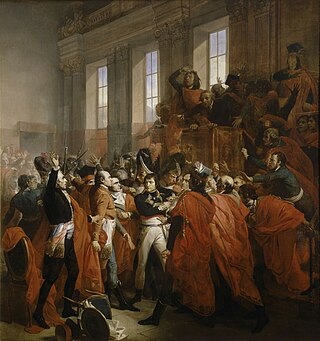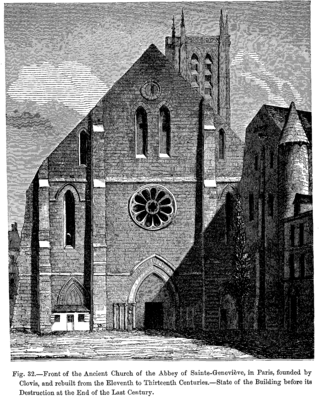A royalist supports a particular monarch as head of state for a particular kingdom, or of a particular dynastic claim. In the abstract, this position is royalism. It is distinct from monarchism, which advocates a monarchical system of government, but not necessarily a particular monarch. Most often, the term royalist is applied to a supporter of a current regime or one that has been recently overthrown to form a republic.

The Directory was the governing five-member committee in the French First Republic from 26 October 1795 until November 1799, when it was overthrown by Napoleon Bonaparte in the Coup of 18 Brumaire and replaced by the Consulate. In mainstream historiography, the term Directoire is also used to refer to the period, coinciding with the final four years of the French Revolution.

The Society of the Friends of the Constitution, renamed the Society of the Jacobins, Friends of Freedom and Equality after 1792 and commonly known as the Jacobin Club or simply the Jacobins, was the most influential political club during the French Revolution of 1789. The period of its political ascendancy includes the Reign of Terror, during which well over 10,000 people were put on trial and executed in France, many for political crimes.

The following is a timeline of the French Revolution.

The National Convention was the constituent assembly of the Kingdom of France for one day and the French First Republic for its first three years during the French Revolution, following the two-year National Constituent Assembly and the one-year Legislative Assembly. Created after the great insurrection of 10 August 1792, it was the first French government organized as a republic, abandoning the monarchy altogether. The Convention sat as a single-chamber assembly from 20 September 1792 to 26 October 1795.

Orléanist was a 19th-century French political label originally used by those who supported a constitutional monarchy expressed by the House of Orléans. Due to the radical political changes that occurred during that century in France, three different phases of Orléanism can be identified:

The French Second Republic, officially the French Republic, was the second republican government of France. It existed from 1848 until its dissolution in 1852.
This glossary of the French Revolution generally does not explicate names of individual people or their political associations; those can be found in List of people associated with the French Revolution.

The Council of Five Hundred was the lower house of the legislature of the French First Republic under the Constitution of the Year III. It operated from 31 October 1795 to 9 November 1799 during the Directory period of the French Revolution.

The 16 May 1877 crisis was a constitutional crisis in the French Third Republic concerning the distribution of power between the president and the legislature. When the royalist president Patrice MacMahon dismissed the Moderate Republican prime minister Jules Simon, the parliament on 16 May 1877 refused to support the new government and was dissolved by the president. New elections resulted in the royalists increasing their seat totals, but nonetheless resulted in a majority for the Republicans. Thus, the interpretation of the 1875 Constitution as a parliamentary system prevailed over a presidential system. The crisis ultimately sealed the defeat of the royalist movement, and was instrumental in creating the conditions for the longevity of the Third Republic.
The Law of 22 Floréal Year VI was a law—arguably constituting a bloodless coup—passed on 11 May 1798 by which 106 left-wing deputies were deprived of their seats in the Council of Five Hundred, the lower house of the legislature under the French Directory. Following the Coup of Fructidor, the power of the Monarchists and the Royalists was largely broken. However, in order to do this, the Directory needed to rely on support from the Left.
Legislative elections were held in France between 9 and 18 April 1798 to elect one-third of the members of the Council of Five Hundred and the Council of Ancients, the lower and upper houses of the legislature, as well as 201 vacant seats. They marked the beginning of the end of the French far-left and rise of the anti-Montagnard and anti-Jacobin groupings. The 1798 elections were partially invalidated by the passage of the Law of 22 Floréal Year VI which saw 106 Montagnards lose their seats by decree of the Council of Five Hundred.
Legislative elections were held in France between 12 and 21 October 1795 to elect one-third of the members of the Council of Five Hundred and the Council of Ancients, the lower and upper houses of the legislature. The elections were held in accordance with the Constitution of the Year III and the first under the Directory regime.

The Society of the Friends of the Constitution, better known as Feuillants Club, was a political grouping that emerged during the French Revolution. It came into existence on 16 July 1791. The assembly split between the Feuillants on the right, who sought to preserve the position of the king and supported the proposed plan of the National Constituent Assembly for a constitutional monarchy; and the Jacobins on the left, who wished to press for a continuation of the overthrow of Louis XVI. It represented the last and most vigorous attempt of the moderate constitutional monarchists to steer the course of the revolution away from the radical Jacobins.

The White Terror was a period during the French Revolution in 1795 when a wave of violent attacks swept across much of France. The victims of this violence were people identified as being associated with the Reign of Terror – followers of Robespierre and Marat, and members of local Jacobin clubs. The violence was perpetrated primarily by those whose relatives or associates had been victims of the Great Terror, or whose lives and livelihoods had been threatened by the government and its supporters before the Thermidorean Reaction. Principally, these were, in Paris, the Muscadins, and in the countryside, monarchists, supporters of the Girondins, those who opposed the Civil Constitution of the Clergy and those otherwise hostile to the Jacobin political agenda.

The Coup of 18 Fructidor, Year V, was a seizure of power in France by members of the Directory, the government of the French First Republic, with support from the French military. The coup was provoked by the results of elections held months earlier, which had given the majority of seats in the country's Corps législatif to royalist candidates, threatening a restoration of the monarchy and a return to the ancien régime. Three of the five members of the Directory, Paul Barras, Jean-François Rewbell and Louis Marie de La Révellière-Lépeaux, with support of foreign minister Charles Maurice de Talleyrand-Périgord, staged the coup d'état that annulled many of the previous election's results and ousted the monarchists from the legislature.

The Panthéon club was a French revolutionary political club founded in Paris the 6 November 1795. Its official name was Reunion of Friends of the Republic. It was composed of former terrorists and unconditional Jacobins coming from the petite bourgeoisie.
Legislative elections were held in France between 9 and 16 April 1799 to elect one-third of the members of the Council of Five Hundred and the Council of Ancients, the lower and upper houses of the legislature.
The Liberals was a short lived French liberal political party which was active in several elections before being absorbed into the Doctrinaires, a fellow constitutional monarchy party. Several members of the Liberals eventually went on to serve in the Movement Party and even later in the Orléanist parties. The precedent set by the party would help form modern French classical liberalism, something used in the modern centre-right Republicans party.










